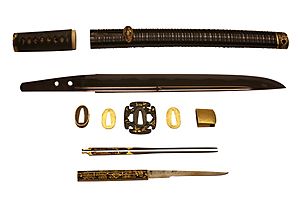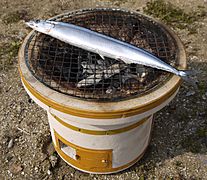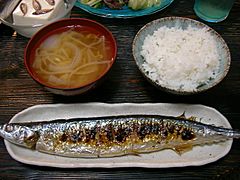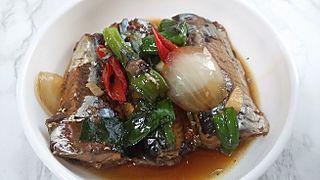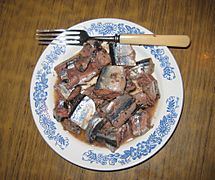Pacific saury facts for kids
Quick facts for kids Pacific saury |
|
|---|---|
 |
|
| Scientific classification | |
| Synonyms | |
|
The Pacific saury (Cololabis saira) is a type of fish that belongs to the Scomberesocidae family. Many people in East Asia enjoy eating saury. It is also known as the mackerel pike.
Contents
About the Pacific Saury
The Pacific saury has a small mouth and a long, thin body. It has tiny finlets between its dorsal (top) and anal fins (bottom). Its tail is small and forked. The fish is dark green to blue on its back and silvery underneath. It also has small, bright blue spots on its sides.
When caught, saury are usually about 25-30 cm (10-12 inches) long. They can grow up to 40 cm (16 inches) long. In autumn, they weigh around 180 grams (6.3 ounces). Most saury live for about four years.
Where Saury Live
Pacific saury are pelagic fish, which means they live in the open ocean, not near the bottom. They usually stay close to the surface of the water, but they can dive down to about 230 meters (750 feet) deep. When saury need to escape from predators, they can float on the surface of the water, just like other fish in their group.
These fish often swim together in large schools. You can find them in the North Pacific Ocean. This area stretches from Korea and Japan all the way east to the Gulf of Alaska. They also swim south to warmer waters near Mexico. They prefer water temperatures between 15 and 18 degrees Celsius (59-64 degrees Fahrenheit).
Saury Life Cycle
The Pacific saury is a fish that travels a lot. It is a highly migratory species. Adult saury usually live far offshore, swimming in schools near the ocean's surface. Younger saury often hang out near floating seaweed.
Pacific saury are oviparous, which means they lay eggs. Their eggs have special threads on their shells. These threads help the eggs stick to floating things, like seaweed, in the ocean.
What Saury Eat
Saury eat tiny ocean creatures called zooplankton. Their diet includes small crustaceans like copepods, krill, and amphipods. They also eat the eggs and young (larvae) of other common fish, such as anchovies. Saury do not have a stomach and have short, straight intestines.
Sometimes, saury may have small, red, worm-like parasites inside them. These parasites are called Rhadinorhynchus selkirki, but they are harmless to humans.
Saury Predators
Many animals hunt Pacific saury. Some of their natural predators include large marine mammals, squid, and tuna.
Pacific Saury Around the World
The Pacific saury is an important food fish in many countries.
Japan
In Japan, Pacific saury is called sanma (さんま / サンマ / 秋刀魚) or saira (さいら / サイラ /佐伊羅). The name saira comes from a local name for the fish in the Kii Peninsula region of Japan.
The Japanese name sanma (秋刀魚) means "autumn knife fish." This name describes its body shape, which looks a bit like a katana (a Japanese sword). It also refers to autumn, which is when the fish is at its best for eating. This name started in Japan and then spread to China.
Sanma is one of the most popular seasonal foods in autumn in Japanese cuisine. It is usually salted and grilled whole. People often serve it with grated daikon radish, a bowl of rice, and miso soup. Other toppings can include soy sauce, sudachi, lime, lemon, or other citrus juices.
The inside parts of the fish can taste bitter. However, many people choose not to remove them because they believe this bitterness, balanced with the toppings, is part of the delicious experience. Autumn saury is rich in fat and has a special flavor.
Sanma sashimi (raw fish) is becoming more common but is still not widely available. While it is rarely used for sushi, sanma-zushi is a special dish in some parts of the Kii Peninsula. This sushi is made by pickling the saury in salt and vinegar, then placing it on top of vinegared rice.
Sometimes, saury with a yellow tail and mouth, or even a yellow body, are caught. These are very rare and are sold for high prices as luxury fish. Scientists are still trying to figure out why some saury turn yellow.
When cooked, saury is easy to prepare because it does not have large scales to remove. Also, people often cook it without taking out the insides or gills. This makes it a good fish for beginners to cook.
Korea
In Korean, saury is called kkongchi (꽁치). Gwamegi is a Korean dish made from half-dried Pacific saury during winter. It is mostly eaten in the North Gyeongsang Province region, where many saury are caught.
Kkongchi-jorim (꽁치조림) is a common Korean dish where saury is simmered in a sauce. Salt-grilled saury is known as kkongchi gui (꽁치구이) in Korea.
China
In Chinese, Pacific saury is called qiū dāo yú (秋刀鱼 in Simplified Chinese or 秋刀魚 in Traditional Chinese). This name also means "autumn knife fish."
Russia
In Russian, saury is called saira (сайра). Pacific saury is popular in Russia, especially in areas close to the Pacific Ocean. In Russia, it is often sold canned with salt and spices. Sometimes, vegetable oil or tomato sauce is added. People also enjoy eating smoked saury.
United Kingdom
Pacific saury are brought to the United Kingdom. There, they are used as bait for fishing for pike and other sea fish. In the UK, they are often called blueys. This might be because people sometimes confuse them with blue mackerel.
Fishing for Saury
Around 1950, Japan caught about 98% of all Pacific saury, and South Korea caught about 2%. However, Japan's share of the catch has become smaller over the years. Today, other countries like China and Taiwan also catch a lot of saury.
The Soviet Union also fished for saury from around 1960 until it broke apart. Taiwan started fishing for saury around 1988 and has been catching more and more. In 2002, China also began fishing for saury, and they now catch over 100,000 tons each year.
Gallery
Images for kids


